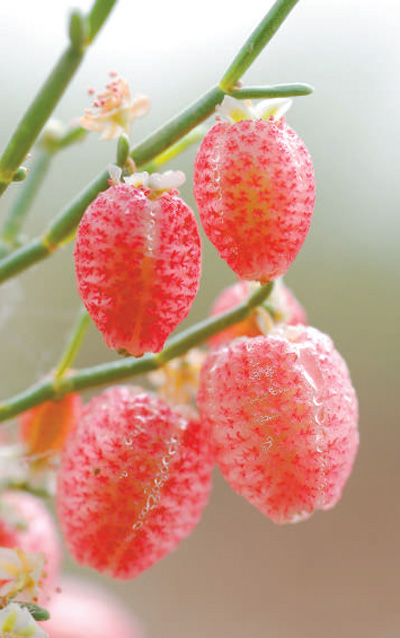Combating desertification yields benefits, creates conditions for construction of first botanical garden in China’s Xinjiang

Photo shows blossoms of Chinese tamarisk, a species which lives in peripheral areas of desert rivers and lakes. (Photo/People’s Daily)

Photo shows fruits of Calligonum junceum, a desert plant. (Photo/People’s Daily)
At the world’s only botanical garden located below sea level-- the Turpan Eremophytes Botanic Garden in northwest China’s Xinjiang Uygur Autonomous Region, more than 500 species of desert plant are thriving. However, more than 40 years ago, this place was a desert, with hardly any living plants.
“At first, we didn’t go there to build a botanical garden, but were instead invited by the local government to tame desertification,” said Pan Borong, a research fellow with the Xinjiang Institute of Ecology and Geography under the Chinese Academy of Sciences (CAS). “After we had made some progress on sand control, we started to build the botanical garden,” Pan explained.
In the last century, the site of the botanical garden was a barren desert. “Nothing could grow here, except for a few plants that could be found only along irrigation canals and ditches in the winter seasons, including camel thorns, deer horn grass and reeds,” said Pan. In 1971, sci-tech personnel from the Xinjiang Institute of Biology and Pedology under the CAS came to the desert at the invitation of the local government, and the next year, a desertification control station was established. Pan became a member of the desertification control team in 1973.
According to Pan, water is of vital importance in planting sand-fixing plants in the desert where the temperature can exceed 82 degrees Celsius.
“The karez irrigation system, which consists of wells that pump underground water to the ground surface, provided water for irrigation of the desert. After the winter irrigation season ended, the water that hadn’t been used was collected to irrigate the desert. This was a key step in carrying out trial planting of sand-fixing forests,” Pan explained.
“In winter, the temperature in Turpan is generally around minus 15 degrees Celsius, and can even drop to minus 28 degrees Celsius. This makes irrigating the desert in winter an arduous task,” Pan said.
After having conducted on-site surveys and investigations, and using their knowledge of local climate, soil, and sand conditions, the sci-tech personnel introduced over 10 types of wind-resistant, sand-fixing, and drought-tolerant plants from around the country and successfully cultivated them. In 1975, they began building a botanical garden, the first of this type in Xinjiang, for better introduction, collection and cultivation of various types of plants which made their home in arid desert areas.
As the plants were sparsely scattered throughout the vast deserts, it was a long journey to collect them, Pan said, explaining that he and his colleagues had left traveled through desert areas in Xinjiang, Gansu Province and Ningxia Hui Autonomous Region, with these trips being full of dangers and risks. After collecting the plants, Pan and his colleagues would take great efforts to cultivate them. However, due to strong winds, which are common weather events during spring in Turpan, the saplings and trees they had planted years before were destroyed. In these cases, they had to start over again by cultivating new saplings they had collected, Pan said.
After many attempts and failures, the sci-tech personnel gradually boosted the botanical garden’s biodiversity. Nowadays, the garden has turned into a hospitable place, with grapevines nearby. In addition, some people have settled down in the area, after arriving from other parts of the country. “This indicates that our efforts to fix the sand over the past decades have yielded fruitful results,” said Dr. Wang Xiyong, who is an assistant researcher with the Xinjiang Institute of Ecology and Geography under the CAS.
Wang explained that the botanical garden has introduced and cultivated more than 500 species of desert plants, including nearly 60 rare and endangered species. In addition, it has built germplasm banks which keep more than over 3,500 shares of desert plant seeds in 600 types.
The botanical garden has provided a total of over 1 million desert plants and more than 50 metric tons of seeds for the construction of various forest construction projects, sand fixation, and governance projects, and additional projects to return farmland to forest or grassland, making active contributions to the prevention and control of desertification and developing the sand industry.
Photos
Related Stories
- Post-90s Xinjiang girl spends 21 years photographing rare animals
- Slow trains continue to serve residents of remote areas with stable ticket prices, services in Xinjiang
- Xinjiang's consumer market sees notable recovery in Q1
- Magnificent scenery of Red River Valley in NW China's Xinjiang
- Daily life of straight-A twin brothers in NW China's Xinjiang
- Xinjiang officials boost local development by attracting massive viewership on short-video sharing platforms
- Working people in Xinjiang enjoy labor rights: official
- Xinjiang's first plateau airport starts operation
- Cotton farming in full swing in China's Xinjiang
- Xinjiang shares information on social, economic development with Omani guests
Copyright © 2022 People's Daily Online. All Rights Reserved.










